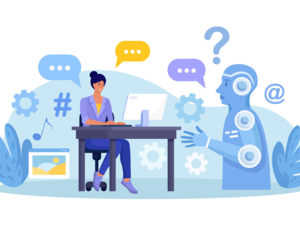 iStock
iStockWork’s main issue is no longer the future of inanimate bricks and mortar of offices — significant economically though this is to city centers, commutes and the real-estate industry. Nor is it about the alternative “space” of the much-vaunted metaverse, which Wired Magazine describes as so vague that if you replace it with cyberspace “ninety percent of the time, the meaning won’t substantially change.”
Instead, the next chapter of work concerns the gamechanger of ChatGPT, which arrived in November 2022. It took everyone by surprise, gaining about one million users in five days. OpenAI’s conversational chatbot not only blew open the doors on the idea that computers could generate ideas and de facto mimic humans, but it heralded a new era in which white collar professional workers were directly threatened.
This group’s job security had previously been inoculated against the arrival of new technology. Now articles with titles like “How To Save Your Job From ChatGPT” are aimed squarely at such workers and it’s a shock to the system. The promise is that AI will save time, save work, allow humans to be their best creative selves, but the risk is the exact opposite.
By way of illustration, I typed this article on a very fast new laptop. It was definitely quicker than a typewriter or old-fashioned pen and paper, so I’m not complaining and I’m not naïve. But if I tell you that the AI-assisted tools have made my task significantly slower due to all the pop-ups and “intuitive” suggestions you might smile indulgently at my technophobia. You might also nod in recognition: This isn’t generative AI but its sibling, predictive AI. For the first time my “knowledge work,” as the great management guru Peter Drucker called it, is constantly being interrupted by a noisy digital “co-worker” trying to being “useful.”
Replacement Anxiety
The authors of a new book The Coming Wave: Technology, Power and the Twenty First Century’s Greatest Dilemma identify a new kind of human creature who they call “homo technologicus — the technological animal.”
This may sound like a cute sound-bite, but it has the ring of truth. Thanks to generative AI and in particular ChatGPT, the porous line between human and machine is becoming confused. So much so that the central issue facing people in the workplace can be summed up in one word: authenticity.
I asked Alice Sherwood, visiting senior fellow at the Policy Institute at King’s College London and author of Authenticity: Reclaiming Reality in a Counterfeit Culture, what an age of generative AI means for worker identity. The concept of being true to yourself originated in the 1960s with the British psychoanalyst Donald Winnicott, but more recently took a workplace setting when Harvard Professor Bill George wrote the best-selling Authentic Leadership: Rediscovering the Secrets to Creating Lasting Value. The authentic self at work has come to mean a shorthand for showing your true self as someone who is therefore more trustworthy. But Sherwood notes that authenticity has become complicated by a new fear: replacement anxiety.
While AI can already do many jobs better than humans, such as form-filling, blurb writing, assessing X-rays and developing new drugs, it can’t make human connections with colleagues and clients — but that may be about to change, Sherwood said. An employer can already use generative AI to make plausible, deepfake videos of their employees. If they add in a voice imitator that offers “ultra-realistic text-to-speech fakery” they can script staff to speak the company’s words in their own voices.
“No wonder employees are uneasy. When there’s a deepfake that looks like you, sounds like you, never gets tired, never goes on holiday, and can even phone your mother why wouldn’t they get the job instead of you?” Sherwood said “But replacement anxiety is about more than a loss of jobs, it’s about a loss of identity. Who has the right to your digital self, your facial features, your voiceprint, and who can put words into your mouth, is set to become one of the hottest legal and employment issues.”
Recent research from the Wharton School of the University of Pennsylvania echoed Sherwood’s view on replacement anxiety, noting that “LLM technology in the form of ChatGPT4, a technology available for just a few months at the time of our experiments, is already significantly better at generating new product ideas than motivated, trained engineering and business students at a highly selective university.”
History Books
Let’s look at this moment in the context of the history of work and of new technology. It’s almost always the case that the new bits spook us. The arrival of the printing press was met in fifteenth century Venice with the Polemic Against Printing from the Benedictine monk and scribe Filippo de Strata. Indeed, the path of Mr. Gutenberg and his bible wasn’t smooth.
A leap forward to the middle of the twentieth century takes us to when Moore’s Law first articulated the increase in computing power, a limit AI has arguably breached. Then with the dawn of the internet at the end of the twentieth century — AI after all is about digital operations — we can begin to see what speed and scale can do.
But perhaps the best comparison is Henry Ford’s first assembly line in 1913. The transformative element here wasn’t a large language model, but a production line which moved — literally. The innovation was to introduce physical movement into production at scale and in a sequence human workers slotted into, not vice versa. The rest, as they say, is history: Within a year Ford was mass producing more cars with less people, more “efficiently” than any competitor.
Unsurprisingly, generative AI is projected to become a $1.3 trillion market by 2032.
Skin in the Game
Just as unsurprisingly, there’s a lot of anxiety and it’s beyond jobs. It’s about human agency and autonomy as well as authenticity. There are distinct whiffs of Mary Shelley’s Frankenstein abounding: We worry we’ve created a monster. I especially worry when those with most to gain commercially show this nervousness. That’s exactly what has happened with ChatGPT. Within six months of its’ launch, more than 1,000 technology leaders including Elon Musk and Steve Wozniak, co-founder of Apple Inc., signed an open letter warning that things were getting “out-of-control.”
Disquiet is catching. Prominent writers corralled by the Author’s Guild wrote to AI industry leaders to “compensate us for using our writings, without which AI would be banal and extremely limited.” Recently a central feature of the bitter artist strike in Hollywood hinged on the replacement of humans by AI generated images and at the very least a lowering of pay as a result.
Regeneration — and Regulation
Clearly this moment calls for regulation. In a recent presentation to the UK Parliament, Oxford University Law Professor Jeremias Adams-Prassl noted: “If someone tells you that they can sell you an algorithm, then watch a two minute video and then give you an exact score of your teamworking capabilities, that’s what we call snake-oil AI.”
This moment also calls for prioritization. Adams-Prassl has argued that privacy, information access and keeping the management with the humans will be pivotal to determining whether we rise to this occasion.
Interestingly, the American word for autumn is fall. It’s easy to think we may be falling into a bleak future of work, in which humans don’t regenerate as fast as their technological opposite numbers. But like all moments in history, humans learn to work with the machines.
I’m an optimistic pessimist. I see leaves coming away from trees and fluttering to the ground in an endless cycle of endings and beginnings.







 Get Unlimited Access to The Economic Times
Get Unlimited Access to The Economic Times

